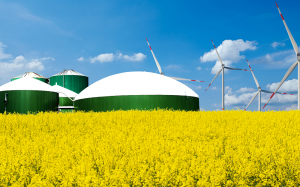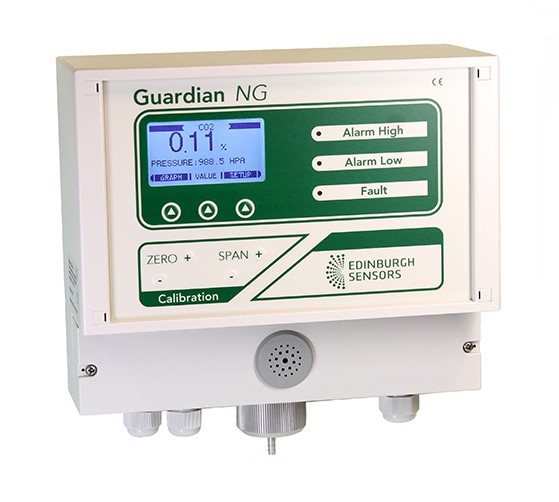The use of biogas as a renewable energy source currently accounts for 10 % of global primary energy consumption1 and is often heralded as the perfect example of the ‘circular economy’ – where waste products can be reused to generate energy for other processes in a self-perpetuating cycle.2
What is Biogas?
Biogas is a mixture of gases produced by the breakdown of organic matter by bacteria under anaerobic (oxygen-free) conditions. The exact chemical composition of biogas depends on the feedstocks used3, but it is usually around 60% methane and 40% carbon dioxide, with trace contaminant gases. The methane content is particularly valuable as this is what can be burnt to provide energy to be used elsewhere.
In biogas production plants, there are several areas where monitoring methane levels is crucial. For safety and environmental purposes, methane sensors are required throughout the plant to check for unwanted leaks. Methane is a significantly more potent greenhouse gas than carbon dioxide, so fugitive emissions must be avoided4 and methane also poses health and safety risk for plant workers in terms of its flammability and as an asphyxiant. As a result, UK Health and Safety legislation cover several aspects of methane use in the workplace, including the Dangerous Substances and Explosive Atmospheres Regulations act5 and the requirement for specific flammable gas detectors.

Image Credit: Natascha Kaukorat/Shutterstock.com
Process Control
The other key area of the biogas plant that requires accurate and rapid methane monitoring is in the biogas reactors themselves. In the digestor, bacteria break down organic waste matter in the absence of oxygen to form the gaseous mixtures that will later undergo refining. It is crucial that process conditions in the digestors, such as temperature, are controlled very carefully to optimise methane yields and production efficiency.6
In order to produce the final biogas product, unwanted gases need to be separated from the high energy-density methane. Here, methane sensors can be used to work out the methane concentrations in the final product before sale.
Edinburgh Sensors
Edinburgh Sensors offer a variety of devices suitable for the online monitoring of methane gas. These are based on nondispersive infrared (NDIR) technologies that provide excellent sensitivity for quantitative and qualitative detection to detect a variety of gases, including methane and carbon dioxide.7
Of Edinburgh Sensors’ range, the Gascard NG8 and Guardian NG9 are both excellent, quick to install stand-alone devices that can be used for online methane monitoring. With only a connection to a reference gas required, they can easily be integrated into existing process monitoring systems to provide robust, real-time data to inform process control and optimisation conditions. For this, both devices offer a R232 interface or, for the Gascard NG, an onboard TCI/IP communications protocol option and the possibility of inclusion of an Ethernet port.

Both the GasCard NG and Guardian NG are ideally suited for methane monitoring as they offer an accuracy of ±2% of range or ±<0.015% of range per mbar. These gas monitors can be installed in a variety of environments. Measurement accuracy is unaffected over 0 – 95 % humidity ranges and measurements have onboard temperature and pressure compensation over a 800 mbar to 1150 mbar range.
Rapid Quantitative Analysis
All of the Edinburgh Sensors OEM sensors for methane analysis offer rapid detection times for quick diagnosis of any process issues. The Gascard NG has a T90 response time of 10 seconds or < 30 seconds for the Guardian NG. Both devices have initial warm up times of just one minute, and operate at full specification after 30 minutes, so there are minimal delays to starting measurements.
The NDIR source and sensors at the heart of the gas detection systems are designed to be field serviceable for minimal downtime. The Guardian NG also comes with an IP54 rated enclosure, which prevents dust or water from interfering with the functioning of the sensor. This ensures reliable, robust measurements for critical processes and safety at all times.
For safety use, the devices can either be connected to an external alarm system, or in the case of the Guardian NG, there is a built-in alarm with a programmable interface. This interface can also be used to display historical readings as well, though both the Guardian NG and Gascard NG can both be connected to external data logging software. Edinburgh Sensors can supply software with the sensors or, where customers have more complex, individual requirements, custom support is also offered.
The sensitivity of the NDIR gas sensors means even very low methane concentrations can be detected, ideal for leak detection, or small variations in the methane concentration as part of the anaerobic digestion processes. Both devices are capable of detecting 0 – 100 % methane concentrations, making them highly flexible devices.
Contact Edinburgh Sensors today to see how their range of OEM technologies offer the best methane detection options to improve the efficiency and safety of your production plants.
References and Further Reading
- Scarlat, N., Dallemand, J. F., & Fahl, F. (2018). Biogas: Developments and perspectives in Europe. Renewable Energy, 129, 457–472. https://doi.org/10.1016/j.renene.2018.03.006
- Circular Economy and Waste Management (2020) European Biogas Association, https://www.europeanbiogas.eu/circular-economy-and-waste-legislation/
- Li, Y., Alaimo, C. P., Kim, M., Kado, N. Y., Peppers, J., Xue, J., … Kleeman, M. J. (2019). Composition and Toxicity of Biogas Produced from Different Feedstocks in California. Environmental Science and Technology, 53, 11569–11579. https://doi.org/10.1021/acs.est.9b03003
- Methane Emissions from Biogas Plants, J.D. Murphy (2017), https://www.ieabioenergy.com/wp-content/uploads/2018/01/Methane-Emission_web_end_small.pdf, accessed 20th December 2020
- DSEAR, Health and Safety Executive (2020) https://www.hse.gov.uk/fireandexplosion/dsear-regulations.htm, accessed 20th December 2020
- Nsair, A., Cinar, S. O., Alassali, A., Qdais, H. A., & Kuchta, K. (2020). Operational Parameters of Biogas Plants: A Review and Evaluation Study. Energies, 13(15). https://doi.org/10.3390/en13153761
- About Us, Edinburgh Sensors (2020), https://edinburghsensors.com/about/about-us/, accessed 20th December 2020
- Gascard NG, Edinburgh Sensors (2020) https://edinburghsensors.com/products/oem-co2-sensor/gascard-ng/, accessed 20th December 2020
- Guardian NG, Edinburgh Sensors (2020) https://edinburghsensors.com/products/gas-monitors/gas-monitor-guardian-ng/, accessed 20th December 2020

